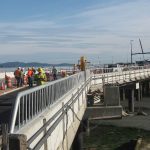Portland Cement Concrete Material Characterization for Pavement ME Design Implementation in Idaho
|
This project began development of a database of portland cement concrete material inputs specific to Idaho in preparation for Idaho’s implementation of the AASHTOWare Pavement ME Design software for designing rigid pavements. The Idaho Transportation Department (ITD is transitioning from pavement design procedures based on the AASHTO 1993 Design Guide to AASHTOWare Pavement ME Design (Pavement ME). Pavement ME requires the definition of more than 100 design input parameters. On the basis of this project’s laboratory test results, the report recommends proper values for all PCC Pavement ME material inputs. ... Read More about Portland Cement Concrete Material Characterization for Pavement ME Design Implementation in Idaho | |










